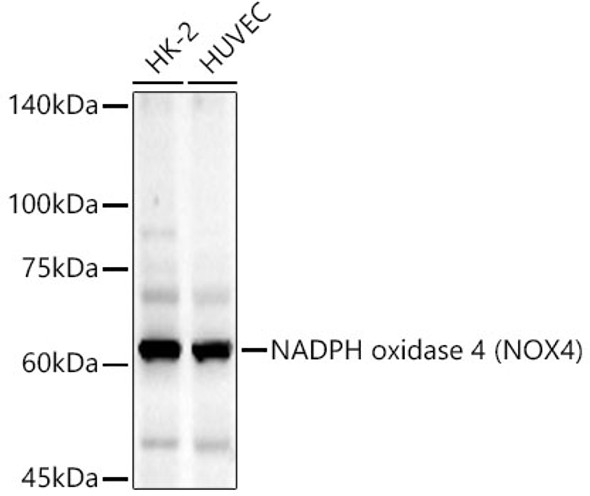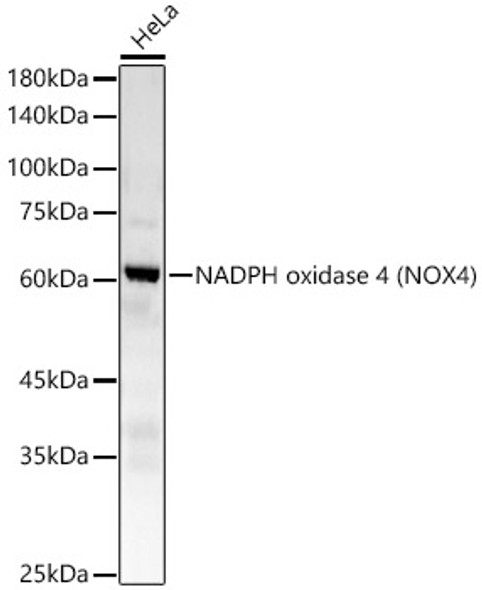Cell Biology Antibodies 17
Anti-NOX4 Antibody (CAB2201)
- SKU:
- CAB2201
- Product Type:
- Antibody
- Reactivity:
- Human
- Reactivity:
- Mouse
- Host Species:
- Rabbit
- Isotype:
- IgG
- Research Area:
- Cell Biology
Description
| Antibody Name: | Anti-NOX4 Antibody |
| Antibody SKU: | CAB2201 |
| Antibody Size: | 20uL, 50uL, 100uL |
| Application: | WB |
| Reactivity: | Human, Mouse |
| Host Species: | Rabbit |
| Immunogen: | Recombinant fusion protein containing a sequence corresponding to amino acids 444-578 of human NOX4 (NP_058627.1). |
| Application: | WB |
| Recommended Dilution: | WB 1:500 - 1:2000 |
| Reactivity: | Human, Mouse |
| Positive Samples: | HeLa, 293T |
| Immunogen: | Recombinant fusion protein containing a sequence corresponding to amino acids 444-578 of human NOX4 (NP_058627.1). |
| Purification Method: | Affinity purification |
| Storage Buffer: | Store at -20'C. Avoid freeze / thaw cycles. Buffer: PBS with 0.02% sodium azide, 50% glycerol, pH7.3. |
| Isotype: | IgG |
| Sequence: | TLLD DWKP YKLR RLYF IWVC RDIQ SFRW FADL LCML HNKF WQEN RPDY VNIQ LYLS QTDG IQKI IGEK YHAL NSRL FIGR PRWK LLFD EIAK YNRG KTVG VFCC GPNS LSKT LHKL SNQN NSYG TRFE YNKE SFS |
| Gene ID: | 50507 |
| Uniprot: | Q9NPH5 |
| Cellular Location: | Cell junction, Cell membrane, Endoplasmic reticulum membrane, Multi-pass membrane protein, Nucleus, focal adhesion, nucleolus |
| Calculated MW: | 6kDa/25-31kDa/58-66kDa |
| Observed MW: | 67kDa |
| Synonyms: | NOX4, KOX, KOX-1, RENOX |
| Background: | This gene encodes a member of the NOX-family of enzymes that functions as the catalytic subunit the NADPH oxidase complex. The encoded protein is localized to non-phagocytic cells where it acts as an oxygen sensor and catalyzes the reduction of molecular oxygen to various reactive oxygen species (ROS). The ROS generated by this protein have been implicated in numerous biological functions including signal transduction, cell differentiation and tumor cell growth. A pseudogene has been identified on the other arm of chromosome 11. Alternative splicing results in multiple transcript variants. |
| UniProt Protein Function: | NOX4: Constitutive NADPH oxidase which generates superoxide intracellularly upon formation of a complex with CYBA/p22phox. Regulates signaling cascades probably through phosphatases inhibition. May function as an oxygen sensor regulating the KCNK3/TASK-1 potassium channel and HIF1A activity. May regulate insulin signaling cascade. May play a role in apoptosis, bone resorption and lipolysaccharide-mediated activation of NFKB. May produce superoxide in the nucleus and play a role in regulating gene expression upon cell stimulation. Isoform 3 is not functional. Isoform 4 displays an increased activity. Isoform 5 and isoform 6 display reduced activity. 7 isoforms of the human protein are produced by alternative splicing. |
| UniProt Protein Details: | Protein type:Membrane protein, integral; EC 1.6.3.-; Membrane protein, multi-pass; Cell cycle regulation; Nucleolus; Oxidoreductase Chromosomal Location of Human Ortholog: 11q14.2-q21 Cellular Component: endoplasmic reticulum membrane; focal adhesion; mitochondrion; perinuclear region of cytoplasm; apical plasma membrane; nucleolus; integral to membrane; stress fiber; NADPH oxidase complex Molecular Function:oxygen sensor activity; electron carrier activity; FAD binding; NAD(P)H oxidase activity; superoxide-generating NADPH oxidase activity; nucleotide binding; heme binding Biological Process: positive regulation of apoptosis; cell morphogenesis; cell aging; homocysteine metabolic process; positive regulation of smooth muscle cell migration; cardiac muscle cell differentiation; positive regulation of MAP kinase activity; negative regulation of cell proliferation; positive regulation of protein kinase B signaling cascade; positive regulation of stress fiber formation; response to hypoxia; inflammatory response; superoxide release; bone resorption |
| NCBI Summary: | This gene encodes a member of the NOX-family of enzymes that functions as the catalytic subunit the NADPH oxidase complex. The encoded protein is localized to non-phagocytic cells where it acts as an oxygen sensor and catalyzes the reduction of molecular oxygen to various reactive oxygen species (ROS). The ROS generated by this protein have been implicated in numerous biological functions including signal transduction, cell differentiation and tumor cell growth. A pseudogene has been identified on the other arm of chromosome 11. Alternative splicing results in multiple transcript variants.[provided by RefSeq, Jan 2009] |
| UniProt Code: | Q9NPH5 |
| NCBI GenInfo Identifier: | 212276447 |
| NCBI Gene ID: | 50507 |
| NCBI Accession: | Q9NPH5.2 |
| UniProt Secondary Accession: | Q9NPH5,Q5K3R4, Q5K3R5, Q5K3R6, Q5K3R8, Q7Z7G3, Q86V92 A8K715, B7Z520, E7EMD7, |
| UniProt Related Accession: | Q9NPH5 |
| Molecular Weight: | Calculated MW: 6kDa/25-31kDa/58-66kDaObserved MW: 67 kDa |
| NCBI Full Name: | NADPH oxidase 4 |
| NCBI Synonym Full Names: | NADPH oxidase 4 |
| NCBI Official Symbol: | NOX4 |
| NCBI Official Synonym Symbols: | KOX; KOX-1; RENOX |
| NCBI Protein Information: | NADPH oxidase 4; kidney oxidase-1; renal NAD(P)H-oxidase; kidney superoxide-producing NADPH oxidase |
| UniProt Protein Name: | NADPH oxidase 4 |
| UniProt Synonym Protein Names: | Kidney oxidase-1; KOX-1; Kidney superoxide-producing NADPH oxidase; Renal NAD(P)H-oxidase |
| Protein Family: | NADPH oxidase |
| UniProt Gene Name: | NOX4 |
| UniProt Entry Name: | NOX4_HUMAN |


![Anti-NOX4 Antibody (CAB11274)[KO Validated] Anti-NOX4 Antibody (CAB11274)[KO Validated]](https://cdn11.bigcommerce.com/s-rd6ounxcu2/images/stencil/590x590/products/39118/43864/anti-nox4-antibody-cab11274ko-validated__07998__72182.1706521213.jpg?c=1)



